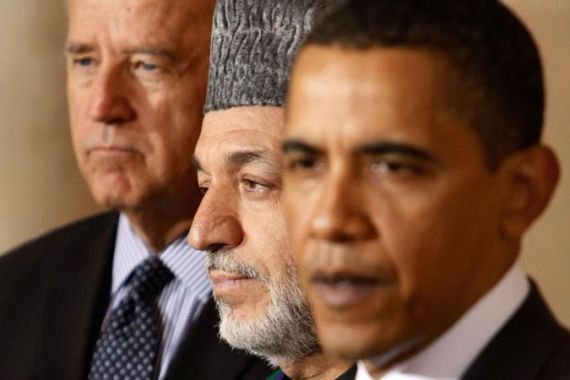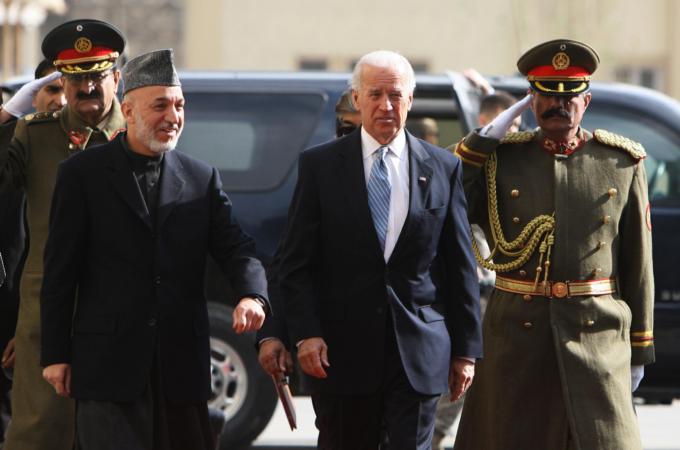US ‘should stay’ in Afghanistan past 2014
A leading think-tank with ties to the Obama Administration says more than 25,000 troops should remain past 2014.

 |
| While US Vice President Joe Biden is welcomed by Afghan President Hamid Karzai there are brooding tensions between the allies [GALLO/GETTY] |
With public and Congressional debate heating up over post-bin Laden US policy in South Asia, a think tank with close ties to the administration of President Barack Obama is calling for a strategy that will keep Washington deeply engaged in the region for a long time to come.
In a 40-page report released on Wednesday, the Center for a New American Security (CNAS) said Washington should negotiate a long-term strategic partnership agreement with Afghanistan that would keep 25,000 to 35,000 US troops in that country well beyond the 2014 date which the US and its allies have set for withdrawal.
It also calls for a “more nuanced” policy towards Pakistan designed to strengthen those state actors that cooperate with US security interests there and punish those that do not, notably military and intelligence officials or sectors suspected of supporting or otherwise cooperating with terrorist groups, notably al-Qaeda, Lashkar-e-Taiba (LeT, and the Pakistani Taliban, Tehrik-i-Taliban).
“As part of a differentiated approach toward Pakistan, the United States should explore using targeted financial pressure against individuals and organisations in Pakistan with links to trans- national terrorism and insurgency in the region,” the report said.
The report, Beyond Afghanistan: A Regional Security Strategy for South and Central Asia also called for Washington to quietly broker confidence-building measures between India and Pakistan, deepen its partnership with New Delhi, promote economic growth by backing open trade and transit throughout the region, and develop a “strategic public engagement plan” aimed at reversing “growing tide of anti-American sentiment,” especially in Pakistan.
The report, which was one year in preparation, comes at a critical moment in the debate over future US policy toward Afghanistan and Pakistan in the aftermath of the killing earlier this month by US Special Forces of al-Qaeda chief Osama bin Laden at a compound where he had reportedly been living for some six years in Abbottabad, Pakistan.
Obama had promised 18 months ago to begin drawing down the 100,000 US troops currently deployed to Afghanistan this July, and bin Laden’s demise has reignited a debate within his administration over the pace and size of that withdrawal.
That debate pits officials, reportedly led by Vice President Joe Biden, who favour a substantial and relatively speedy withdrawal and the transformation of the US role in Afghanistan to a “counterterrorist (CT) strategy”, against those, led by General David Petraeus, who will soon take over the Central Intelligence Agency, who remain committed to a “counterinsurgency (COIN) strategy” that requires Washington to maintain a much-heavier military footprint.
Bin Laden’s death appears to have strengthened the CT forces within the administration, whose case has also been bolstered by growing concern in Congress – on both sides of the aisle – over the financial costs of the COIN strategy when lawmakers are struggling to cut unprecedented budget deficits. The war in Afghanistan is currently costing the Treasury more than $100bn a year.
The fact that bin Laden had been living quietly so long in central Pakistan – and only about one kilometre from that country’s premier military academy and some 60km from the capital – has also sparked considerable debate, especially in Congress, about the future of US policy toward Islamabad.
Despite Islamabad’s denials, many lawmakers, again on both sides of the aisle, have charged that some elements of the Pakistani military and its Inter-Services Intelligence (ISI) division must have known of his location there and thus, at the very least, decided to protect him.
Some have called for Washington to cut off all military and intelligence assistance – estimated at as much as two billion dollars a year – to Pakistan in retaliation.
“The United States is at a strategic inflection point in South and Central Asia,” according to the report, which noted that bin Laden’s death, combined with the scheduled beginning of the US withdrawal from Afghanistan, “presents a new opportunity for the United States to protect its enduring interests in the region.”
Those interests, according to the report, which was co-written by the former NATO commander in Afghanistan, Lt. Gen. David Barno (ret.) and a prominent COIN specialist, Andrew Exum, include, above all, “preventing the region’s use as a base for terror groups to attack the United States;” ensuring nuclear weapons or other weapons of mass destruction do not fall into the hands of terrorists; and preventing a major inter-state war on the subcontinent – particularly one that could escalate to a nuclear conflict.”
The report makes a series of “assumptions” that guide its analysis. In its view, Washington will continue to have an “uneasy relationship” with Pakistan that could at times become “severely stressed, but …unlikely to rupture;” that whatever the pace at which US troops are withdrawn from Afghanistan, the US will retain a “residual force” of between 25,000 and 35,000 troops beyond 2014 unless and until he Taliban insurgency is resolved or al-Qaeda and its affiliates are fully defeated.
Other assumptions include the persistence of an adversarial relationship between India and Pakistan; a “new great game” for the region’s raw materials, minerals, and lines of transportation between China and India; and steadily growing domestic political pressure here both to curb foreign-aid and military budgets and reduce Washington’s involvement in South Asia.
Based on these assumptions, the report recommends that Washington negotiate a “strategic partnership agreement” with the government of Afghan President Hamid Karzai that will permit the retention of the US “residual force” both to advise and assist Afghan security forces against the Taliban and to conduct CT operations against al-Qaeda and its allies. It notes that such a reduced force would cost far less than the current deployments and would offer ancillary benefits, as well.
“A long-term presence of limited US military forces demonstrates the depth of the US commitment to the region – a stabilising presence anxiously sought by neutral countries and friends of the United States alike,” the report asserts.
As to policy toward Islamabad, the report argues that “stability in the region requires stability in Pakistan” and suggests that cutting off assistance or treating the country as an adversary would constitute a strategic mistake.
Nonetheless, Washington should make it clear that “continued covert Pakistani support for terrorist groups” will cross a “red line, triggering suspension of military and intelligence funding.” At a minimum, according to the report, Washington should expect more access to intelligence on al-Qaeda, LeT, and related groups, continued support for US drone strikes against suspected terrorist targets; and protection of the logistical pipeline that supplies US forces in Afghanistan.
At the same time, Washington should use its non-military aid programme in Pakistan – which currently provides $1.5bn a year – “bolster Pakistan’s civilian government vis-à-vis the Pakistani military-intelligence establishment.”
Washington must also devote more resources to countering anti- American sentiment in Pakistan by sponsoring more exchange programmes; using traditional and “new” media to counter the “extremist narrative”; and develop long-term programmes to address anti-Americanism. “Any US strategic partnership with the Pakistani state will simply founder if the Pakistani people continue to view the United States with deep-seated mistrust and suspicion,” it said.
A version of this article first appeared on Inter Press Service news agency.